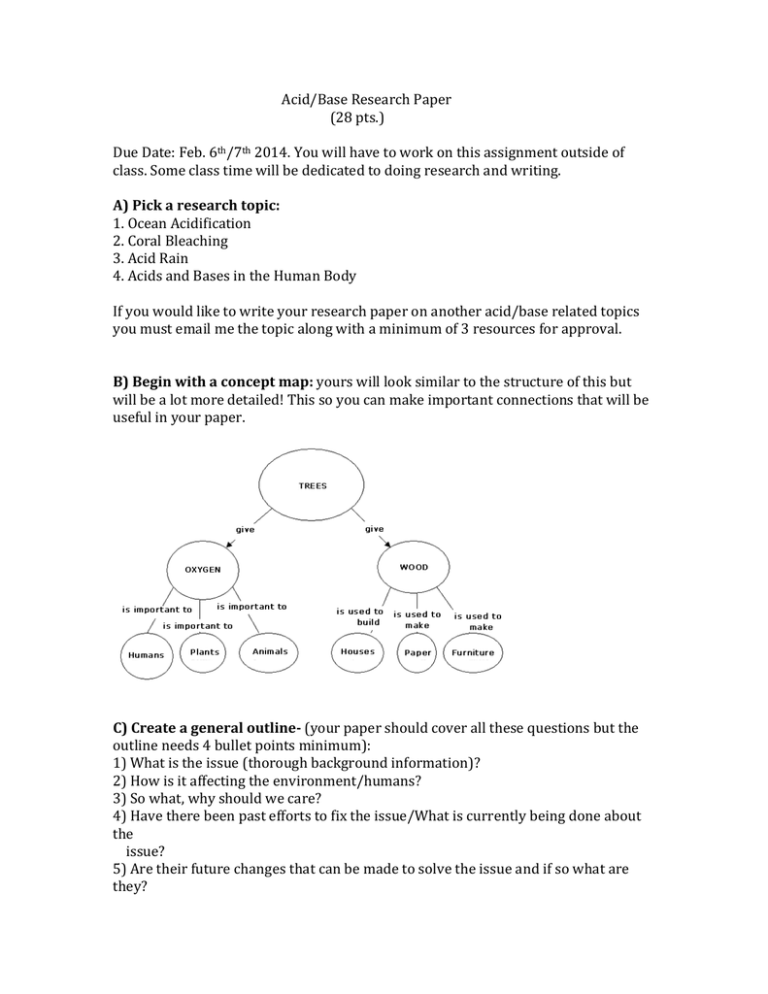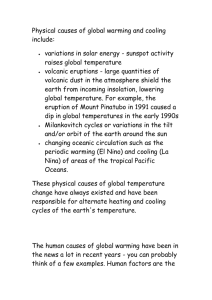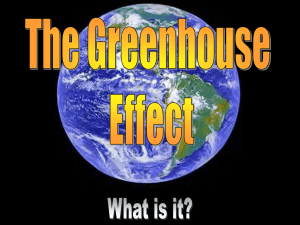Acid/Base Research Paper (28 pts.) Due Date: Feb. 6th/7th 2014
advertisement

Acid/Base Research Paper (28 pts.) Due Date: Feb. 6th/7th 2014. You will have to work on this assignment outside of class. Some class time will be dedicated to doing research and writing. A) Pick a research topic: 1. Ocean Acidification 2. Coral Bleaching 3. Acid Rain 4. Acids and Bases in the Human Body If you would like to write your research paper on another acid/base related topics you must email me the topic along with a minimum of 3 resources for approval. B) Begin with a concept map: yours will look similar to the structure of this but will be a lot more detailed! This so you can make important connections that will be useful in your paper. C) Create a general outline- (your paper should cover all these questions but the outline needs 4 bullet points minimum): 1) What is the issue (thorough background information)? 2) How is it affecting the environment/humans? 3) So what, why should we care? 4) Have there been past efforts to fix the issue/What is currently being done about the issue? 5) Are their future changes that can be made to solve the issue and if so what are they? 6) What can we do right now to help solve the issue? D) At this point you should have completed most of your research. Refer to the rubric for details you need to include in your paper. *** Your paper should be double spaced, Times New Roman, 12 pt. font, 1 inch margins. Science Research Paper Evaluation Rubric Acids/Bases Student Name: Category Concept Map Score: Scoring Criteria Points Separate page showing relationship between concepts 5 Outline Separate page outline clearly summarizes the essential research findings and conclusion in less than 400 words. (bullet points) 5 Title Page Title page consists only of: a descriptive title for the paper, author's name and period 1 Introduction (1/2 page) Report of Research (3-4 pages) Conclusion (1/2 page) A thesis statement makes the research topic clear. Background information is provided to establish the importance of the research topic. 3 Scientific terms and concepts are properly used. 1 Research findings are presented in the student's words, not "cut and pasted". 7 At least one research reference is "quoted". 1 The most important research findings are restated. Student's final thoughts about the research topic are stated. Annotated A single page annotated bibliography is provided. Bibliography 2 1 Professional Vernacular - a single page with all relevant terms defined. Appendix Diagram - at least one diagram or picture of importance related to the research topic is included. 2 Research organization is demonstrated by including the concept map used to plan the paper. Score Total Points 28 ***If students are missing any of the following sections they will have to resubmit the completed paper as late. An example paper for you to read through: (this paper is longer than what yours needs to be and does not include all the sections on the rubric.) National Geographic Environment: Global Warming Global warming describes the current rise in the average temperature of Earth’s air and oceans. Global warming is often described as the most recent example of climate change. Earth’s climate has changed many times. Our planet has gone through multiple ice ages, in which ice sheets and glaciers covered large portions of the Earth. It has also gone through warm periods when temperatures were higher than they are today. Past changes in Earth’s temperature happened very slowly, over hundreds of thousands of years. However, the recent warming trend is happening much faster than it ever has. Natural cycles of warming and cooling are not enough to explain the amount of warming we have experienced in such a short time—only human activities can account for it. Scientists worry that the climate is changing faster than some living things can adapt to it. In 1988, the World Meteorological Organization and the United Nations Environment Program established a committee of climatologists, meteorologists, geographers, and other scientists from around the world. This Intergovernmental Panel on Climate Change (IPCC) includes thousands of scientists who review the most up-to-date research available related to global warming and climate change. The IPCC evaluates the risk of climate change caused by human activities. According to the IPCC’s most recent report (in 2007), Earth’s average surface temperatures have risen about 0.74 degrees Celsius (1.33 degrees Fahrenheit) during the past 100 years. The increase is greater in northern latitudes. The IPCC also found that land regions are warming faster than oceans. The IPCC states that most of the temperature increase since the mid-20th century is likely due to human activities. The Greenhouse Effect Human activities contribute to global warming by increasing the greenhouse effect. The greenhouse effect happens when certain gases—known as greenhouse gases—collect in Earth’s atmosphere. These gases, which occur naturally in the atmosphere, include carbon dioxide, methane, nitrogen oxide, and fluorinated gases sometimes known as chlorofluorocarbons (CFCs). Greenhouse gases let the sun’s light shine onto the Earth’s surface, but they trap the heat that reflects back up into the atmosphere. In this way, they act like the insulating glass walls of a greenhouse. The greenhouse effect keeps Earth’s climate comfortable. Without it, surface temperatures would be cooler by about 33 degrees Celsius (60 degrees Fahrenheit), and many life forms would freeze. Since the Industrial Revolution in the late 1700s and early 1800s, people have been releasing large quantities of greenhouse gases into the atmosphere. That amount has skyrocketed in the past century. Greenhouse gas emissions increased 70 percent between 1970 and 2004. Emissions of carbon dioxide, the most important greenhouse gas, rose by about 80 percent during that time. The amount of carbon dioxide in the atmosphere today far exceeds the natural range seen over the last 650,000 years. Most of the carbon dioxide that people put into the atmosphere comes from burning fossil fuels such as oil, coal, and natural gas. Cars, trucks, trains, and planes all burn fossil fuels. Many electric power plants also burn fossil fuels. Another way people release carbon dioxide into the atmosphere is by cutting down forests. This happens for two reasons. Decaying plant material, including trees, releases tons of carbon dioxide into the atmosphere. Living trees absorb carbon dioxide. By diminishing the number of trees to absorb carbon dioxide, the gas remains in the atmosphere. Most methane in the atmosphere comes from livestock farming, landfills, and fossil fuel production such as coal mining and natural gas processing. Nitrous oxide comes from agricultural technology and fossil fuel burning. Fluorinated gases include chlorofluorocarbons, hydrochlorofluorocarbons, and hydrofluorocarbons. These greenhouse gases are used in aerosol cans and refrigeration. All of these human activities add greenhouse gases to the atmosphere, trapping more heat than usual and contributing to global warming. Effects of Global Warming Even slight rises in average global temperatures can have huge effects. Perhaps the biggest, most obvious effect is that glaciers and ice caps melt faster than usual. The meltwater drains into the oceans, causing sea levels to rise and oceans to become less salty. Ice sheets and glaciers advance and retreat naturally. As Earth’s temperature has changed, the ice sheets have grown and shrunk, and sea levels have fallen and risen. Ancient corals found on land in Florida, Bermuda, and the Bahamas show that the sea level must have been 5 to 6 meters (16-20 feet) higher 130,000 years ago than it is today. Earth doesn’t need to become oven-hot to melt the glaciers. Northern summers were just 3 to 5 degrees Celsius (5-9 degrees Fahrenheit) warmer during the time of those ancient fossils than they are today. However, the speed at which global warming is taking place is unprecedented. The effects are unknown. Glaciers and ice caps cover about 10 percent of the world’s landmass today. They hold about 75 percent of the world’s fresh water. If all of this ice melted, sea levels would rise by about 70 meters (230 feet). The IPCC reported that the global sea level rose about 1.8 millimeters (0.07 inches) per year from 1961 to 1993, and 3.1 millimeters (0.12 inches) per year since 1993. Rising sea levels could flood coastal communities, displacing millions of people in areas such as Bangladesh, the Netherlands, and the U.S. state of Florida. Forced migration would impact not only those areas, but the regions to which the “climate refugees” flee. Millions more people in countries like Bolivia, Peru, and India depend on glacial meltwater for drinking, irrigation, and hydroelectric power. Rapid loss of these glaciers would devastate those countries. Glacial melt has already raised the global sea level slightly. However, scientists are discovering ways the sea level could increase even faster. For example, the melting of the Chacaltaya Glacier in Bolivia has exposed dark rocks beneath it. The rocks absorb heat from the sun, speeding up the melting process. Many scientists use the term “climate change” instead of “global warming.” This is because greenhouse gas emissions affect more than just temperature. Another effect involves changes in precipitation like rain and snow. Patterns in precipitation may change or become more extreme. Over the course of the 20th century, precipitation increased in eastern parts of North and South America, northern Europe, and northern and central Asia. However, it has decreased in parts of Africa, the Mediterranean, and parts of southern Asia. Future Changes Nobody can look into a crystal ball and predict the future with certainty. However, scientists can make estimates about future population growth, greenhouse gas emissions, and other factors that affect climate. They can enter those estimates into computer models to find out the most likely effects of global warming. The IPCC predicts that greenhouse gas emissions will continue to increase over the next few decades. As a result, they predict the average global temperature will increase by about 0.2 degrees Celsius (0.36 degrees Fahrenheit) per decade. Even if we reduce greenhouse gas and aerosol emissions to their 2000 levels, we can still expect a warming of about 0.1 degree Celsius (0.18 degrees Fahrenheit) per decade. The panel also predicts global warming will contribute to some serious changes in water supplies around the world. By the middle of the 21st century, the IPCC predicts, river runoff and water availability will most likely increase at high latitudes and in some tropical areas. However, many dry regions in the mid-latitudes and tropics will experience a decrease in water resources. As a result, millions of people may be exposed to water shortages. Water shortages decrease the amount of water available for drinking, electricity, and hygiene. Shortages also reduce water used for irrigation. Agricultural output would slow and food prices would climb. Consistent years of drought in the Great Plains of the United States and Canada would have this effect. IPCC data also suggest that the frequency of heat waves and extreme precipitation will increase. Weather patterns such as storms and tropical cyclones will become more intense. Storms themselves may be stronger, more frequent, and longer-lasting. They would be followed by stronger storm surges, the immediate rise in sea level following storms. Storm surges are particularly damaging to coastal areas because their effects (flooding, erosion, damage to buildings and crops) are lasting. What We Can Do Reducing our greenhouse gas emissions is a critical step in slowing the global warming trend. Many governments around the world are working toward this goal. The biggest effort so far has been the Kyoto Protocol, which was adopted in 1997 and went into effect in 2005. By the end of 2009, 187 countries had signed and ratified the agreement. Under the protocol, 37 industrialized countries and the European Union have committed to reducing their greenhouse gas emissions. There are several ways that governments, industries, and individuals can reduce greenhouse gases. We can improve energy efficiency in homes and businesses. We can improve the fuel efficiency of cars and other vehicles. We can also support development of alternative energy sources, such as solar power and biofuels, that don’t involve burning fossil fuels. Some scientists are working to capture carbon dioxide and store it underground, rather than let it go into the atmosphere. This process is called carbon sequestration. Trees and other plants absorb carbon dioxide as they grow. Protecting existing forests and planting new ones can help balance greenhouse gases in the atmosphere. Reducing greenhouse gas emissions is vitally important. However, the global temperature has already changed and will most likely continue to change for years to come. The IPCC suggests that people explore ways to adapt to global warming as well as try to slow or stop it. Some of the suggestions for adapting include: Expanding water supplies through rain catchment, conservation, reuse, and desalination. Adjusting crop locations, variety, and planting dates. Building seawalls and storm surge barriers and creating marshes and wetlands as buffers against rising sea levels. Creating heat-health action plans, boosting emergency medical services, and improving disease surveillance and control. Diversifying tourism attractions, because existing attractions like ski resorts and coral reefs may disappear. Planning for roads and rail lines to cope with warming and/or flooding. Strengthening energy infrastructure, improving energy efficiency, and reducing dependence on single sources of energy.








